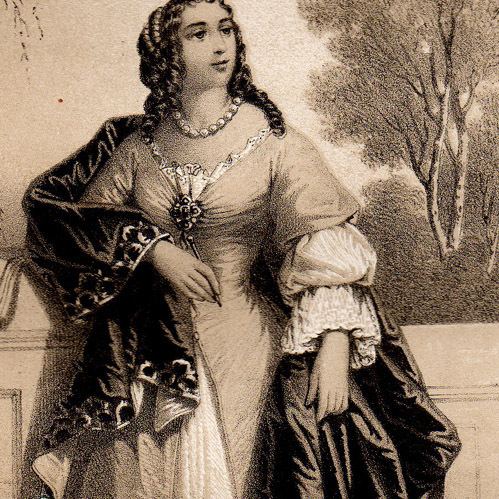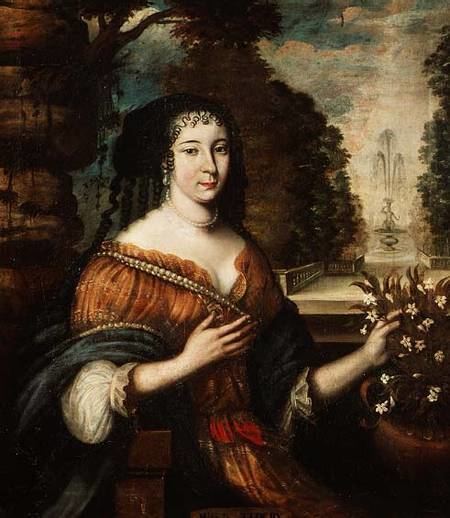Language French Role Writer Name Madeleine Scudery | Genre Novels Siblings Georges de Scudery | |
 | ||
Born 15 November 1607Le Havre, Normandy ( 1607-11-15 ) Died June 2, 1701, Paris, France Books Artamene, The Story of Sapho, Selected Letters - Orations, Les Conversations Sur Diver | ||
Madeleine de scud ry
Madeleine de Scudéry (15 November 1607 – 2 June 1701), often known simply as Mademoiselle de Scudéry, was a French writer. She was the younger sister of author Georges de Scudéry.
Contents

Madeleine de Scudéry
Biography

Born at Le Havre, Normandy, in northern France, she is said to have been very plain as well as without fortune, but she was exceedingly well-educated. Her father, captain of the port in Le Havre, died in 1613 with her mother following shortly after. Madeleine and her brother Georges de Scudéry were placed in the care of an uncle who cared for them very well. He gave Madeleine an abnormally well-rounded education: she studied writing, spelling, drawing, dancing, painting, and needlework. In addition, on her own, Madeleine studied agriculture, medicine, cooking, Spanish, and Italian. Her works also demonstrate comprehensive knowledge of ancient history that it is suspected she had received instruction in Greek and Latin. In 1637, following the death of her uncle, Scudéry established herself at Paris with her brother. Georges de Scudéry became a playwright. Madeleine often used her brother's name to publish her works. She was at once admitted to the Hôtel de Rambouillet coterie, and afterwards established a salon of her own under the title of the Société du samedi (Saturday Society). For the last half of the 17th century, under the pseudonym of Sapho or her own name, she was acknowledged as the first bluestocking of France and of the world. She formed a close friendship with Paul Pellisson which was only ended by his death in 1693. She never married.
Works

Her lengthy novels, such as Artamène, ou le Grand Cyrus (10 vols., 1648–53), Clélie (10 vols., 1654–61), Ibrahim, ou l'illustre Bassa (4 vols., 1641), Almahide, ou l'esclave reine (8 vols., 1661-3) were the delight of Europe, commended by other literary figures such as Madame de Sévigné. Artamène, which contains about 2.1 million words, ranks as the longest novel ever published. Her novels derive their length from endless conversations and, as far as incidents go, successive abductions of the heroines, conceived and told decorously. Contemporary readers also enjoyed these novels because they gave a glimpse into the life of important society figures. These figures were often disguised as Persian, Greek, and Roman warriors and maidens. In fact, Scudéry created the roman à clef to provide a forum for her thinly veiled fiction featuring political and public figures.

Les Femmes Illustres (1642) addresses itself to women and defends education, rather than the beauty or cosmetic, as a means of social mobility for women. This text was a means to justify women's participation in rhetoric and literary culture. It uses women speakers as models for the speeches, including Cleopatra of Egypt. In Les Femmes Illustres (1642), Conversations Sur Divers Sujets (1680), and Conversations Nouvelles sur Divers Sujets, Dediees Au Roy (1684), Madeleine de Scudéry adapted classical rhetorical theory from Cicero, Quintilian, Aristotle, and the sophists to a theory of salon conversation and letter writing. Scudéry's Conversations Sur Divers Sujets, included dialogues covering "Conversation," "The Art of Speaking," "Raillery," "Invention," and "The Manner of Writing Letters." This text offers the rhetoric of salon conversation and model scenarios where women take intellectual control of the conversation. Other works devoted to conversations, pertaining to the education of women include: "The Slave Queen" (1660), "Mathilda of Aguilar, a Spanish Tale," (1667), and "The Versailles Promenade, or the Tale of Celanire" (1669). These covered the art of speaking, invention, the manner of writing letters, and scenarios where women had control of the intellectual conversation.
Scudéry's novels are usually set in the classical world or "the Orient", but their language and action reflect fashionable ideas of the 17th century, and the characters can be identified with Mademoiselle de Scudéry's contemporaries. In Clélie, Herminius represents Paul Pellisson; Scaurus and Lyriane were Paul Scarron and his wife (who became Mme de Maintenon); and in the description of Sapho in vol. 10 of Le Grand Cyrus the author paints herself.
In Clélie, Scudéry invented the famous Carte de Tendre, a map of an Arcadia where the geography is all based around the theme of love: the river of Inclination flows past the villages of "Billet Doux" (love letter), "Petits Soins" (Little Trinkets) and so forth. Scudéry was a skilled conversationalist; several volumes purporting to report her conversations upon various topics were published during her lifetime. She had a distinct vocation as a pedagogue.
Later years
Madeleine survived her brother by more than thirty years, and in her later days published numerous volumes of conversations, to a great extent extracted from her novels, thus forming a kind of anthology of her work. Scudéry was deaf for the last 40 years of her life. She outlived her vogue to some extent, but retained a circle of friends to whom she was always the "incomparable Sapho."
Her Life and Correspondence was published at Paris by MM. Rathery and Boutron in 1873.
Legacy
Madeleine de Scudéry was part of a movement in the late Renaissance in England and France where women used classical rhetorical theory for their own. She revised discourse to be modeled on conversation rather than public speaking, favoring that as a means of rhetoric, the speaker in the salon built on the ideas of the speaker before them, opting for consensus rather than argument. She is one of the central figures associated with the "salon" conversation and letter writing.
Literature
Summaries of the stories and keys to the characters may be found in Heinrich Körting, Geschichte des französischen Romans im 17ten Jahrhundert (second edition, Oppeln, 1891).
